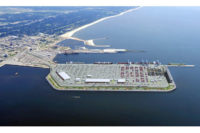A great deal of uncertainty hangs over supply chains as we move into 2022. Yet, the industry can’t wait for that uncertainty to clear before making the investments required to enable supply chains to embrace the changes occurring in the market. That should make 2022 another busy and dynamic year for warehouse operators and their automation partners. Here are four trends expected to take center stage in the coming year.
E-Grocery Orders Get Smaller And More Frequent
The big question coming into 2021 was whether or not demand for e-grocery services would drop steeply from the highs experienced during the early days of the pandemic or would the convenience and time savings offered by online grocery shopping convert first-time users into regular repeat customers.
That question was answered, with certainty, in 2021. Despite online grocery’s share of total sales being up and down on a month-to-month basis, the overall trend was one of growth for this segment. According to a report from strategic advisory firm Brick Meets Clicks, the share of the U.S. grocery market represented by e-grocery pickup and delivery grew to 10% of total sales in 2021, up 2 points from 2020. While the firm saw relative consistency in order frequency through 2021, we expect this to change in 2022.
As consumers get more comfortable with online grocery shopping and the convenience it provides, they will place smaller, more frequent e-grocery orders with those grocers that encourage the online business. This will put further pressure on the productivity and efficiency of in-store order picking as a means of fulfilling online orders. Micro-fulfillment centers (MFCs) and e-fulfillment centers (EFCs) enable greater agility in responding to changing order profiles cost effectively because the automation systems deployed in these facilities provide flexibility and still maintain cost effective fulfillment.
Item Picking Moves Upstream
As order sizes continue to shrink, centralized pallet and case warehouses upstream will begin to expand into individual item picking or break pack in their operations. This trend will be driven by the continuing evolution of the retail landscape and the move into direct-to-consumer sales by manufacturers.
On the retail and grocery front, SKU growth and smaller store formats are limiting shelf space and forcing less inventory to be carried per SKU while keeping or increasing the overall SKU count. Grocers and retailers will be challenged to accept cases of slower moving products at the store level and will instead have to push for single item replenishment of those products. Simultaneously, manufacturers recognize the opportunity in e-commerce and will need to support their entry into B2C from their centralized warehouses by adding item handling capabilities to these facilities.
The result will be the transformation of many warehouses as they integrate new processes and technologies to enable efficient item picking. Goods-to-person technologies, such as cube-based automated storage and retrieval systems and mobile autonomous robots will find a home in warehouses that had previously only supported bulk handling of products.
This trend will also accelerate the adoption of robotic item picking solution. With more advanced gripping and vision systems, newer generation robotic picking solutions are expanding the range of products that can be picked while also offering the highest operational reliability. The central or regional warehouse is an ideal environment for introducing robotic item picking due to the technical support infrastructure available at those sites.
Supply Chain Connectivity Begins To Deliver Global Inventory Visibility
One of the gaps that exists in many supply chains is the inability to gain a comprehensive view of inventory across global distribution and retail and grocery locations. This is a problem in today’s fast-paced and ever-changing distribution landscape as it limits the ability to react to both individual customer requirements and broader market shifts, swiftly and with certainty in mind.
With the digitalization that has already occurred in warehouses and retail stores, this data is readily available at each site throughout the supply chain. But creating interfaces across the various software platforms in any given distribution network is challenging for individual organizations. There is a significant market opportunity for software platforms that can connect disparate systems across a global enterprise and deliver a consolidated view of inventory and its status. We won’t be so bold as to predict that these platforms will be perfect in 2022, but there is no doubt that easy connectivity and the creation of customer intelligence portals it enables is on its way and is unstoppable.
Automation Will Be Used To Attract Workers
As companies continue to deal with labor shortages and workers’ reassessment of warehouse jobs, warehouse automation solutions will help overcome both obstacles. In fact, automation will become a powerful tool in attracting and retaining the skilled labor many companies need.
Jobs in the warehouse can be grueling work, and many in the workforce are deciding it’s not a job they want or need. So even when there are people looking for jobs, companies offering warehouse positions are finding it hard to attract them. This is where automation solutions can help.
Consider those warehouse workers who walk up and down aisles, picking items to fulfill customer orders. It is not uncommon for people in these roles to walk 12 miles or more per shift. Now, imagine those same workers in an environment where an automated storage and picking system is installed. The system’s swarm of mobile vehicles navigate via a grid to deliver mobile racks of items to workstations for picking. This creates a much more inviting environment for warehouse pickers, while also increasing productivity and reducing picking errors.
There are also those workers who are looking to work at a company where exciting new technology is being used to create the global supply chain of the future. These skilled workers want to work alongside technology, such as automation. They see these positions as often requiring a higher skillset and offering career advancement, as well as the ability to focus on more value-added tasks within the operation.
The cold chain has seen unprecedented change over the last several years. Responding to those changes in real time was often an all-consuming task that delayed longer term planning. Now, as we enter 2022, many organizations will find they simply can’t stretch their available resources and systems any further. New distribution strategies and technologies are required to meet the challenges of today and to adapt to the unforeseen changes of the future.



